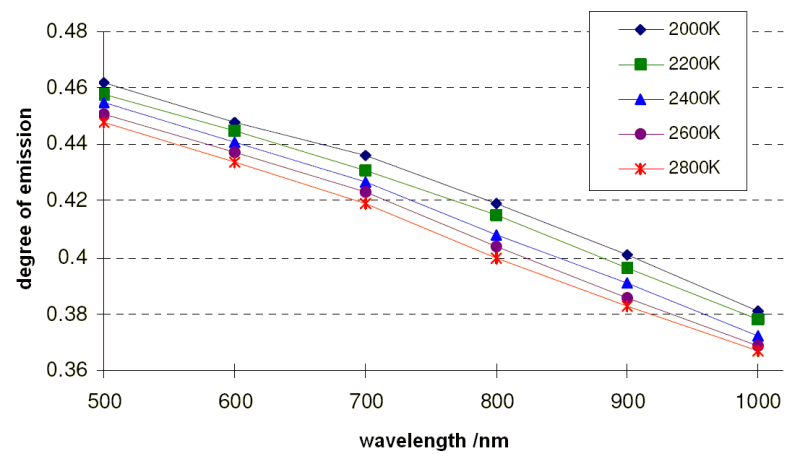2. Thermal radiation
Grey and coloured emitters (2/2)
Incandescent lamps
Although now largely replaced by energy-saving LED lamps, incandescent lamps, or more commonly called filament lamps, are light emitters with spectra that correspond to Planck's law of radiation quite well. This is astonishing at first, because the emissivity of the tungsten filament is very small, as is the case with all polished metals.
The emissivity of tungsten depends on the temperature. It has a value of about 0.03 at 25°C (or 300 K), but grows to about 0.46 at 2000°C (or 1700 K), and conversely drops to about 0.45 at 2800°C (or 2500 K). It also depends very strongly on the wavelength, as the following graph shows.

Emissivity of tungsten depending on the wavelength at several temperatures.
Source: CRC Handbook of Chemistry and Physics, 60th Edition, p. E-381.
The true temperature of the filament of a switched-on incandescent lamp is about 2400 K, and for comparison, halogen lamps operate at around 2700 K. Higher temperatures will produce more light, but will burn through and melt the filament when it gets close to the melting point of tungsten at about 3700K; this decreases the lifespan of the filament. Some lamps capable of very high brightness operate at 3400 K, but burn out after about two hours.
Due to , the radiation temperature of an incandescent lamp is lower than the true temperature. Additionally, the reflection losses of approx. 8% on the glass bulb of the lamp also contribute to this difference. The radiation temperature is often referred to as the black body temperature, because if the object was a black body, it would radiate at this temperature.
While Planck's Law of Radiation cannot describe the brightness of the spectrum very well, it can describe its shape with accuracy. The shape determines the colour of the light, which is why the temperature resulting from the spectral shape is called the colour temperature. The following table shows that the colour temperature agrees with the true temperature much better than the black body temperature.
| True Temperature in K | 1000 | 1500 | 2000 | 3000 |
| Black Body Temperature in K at λ=665 nm | 964 | 1420 | 1857 | 2673 |
| Colour temperature in K | 1006 | 1517 | 2033 | 3094 |
Temperature data for tungsten. Source: Robert W. Pohl, Einführung in die Physik. Dritter Band: Optik und Atomphysik. 13th Edition (Springer, 1979), p. 260.



